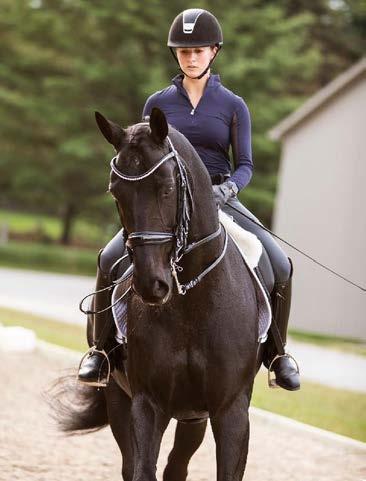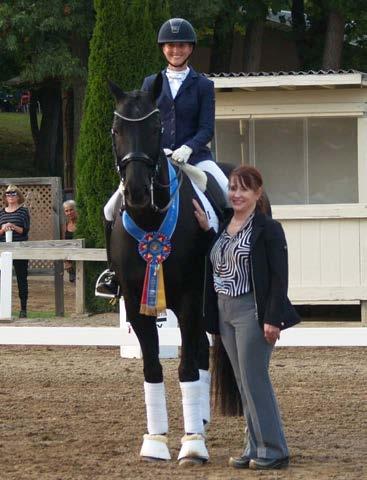
3 minute read
KEEPING YOUR OLDER EQUINE ATHLETE HEALTHY
Written by Bob Grisel, DVM
Photos by J. Klein Photos and Jessica Haney
Advertisement
Regardless of your horse’s age, implementing proactive or preventative therapy can maximize your chances of success in the show ring. As your horse gets older, this approach becomes even more essential. Staying ahead of problems helps you to avoid frustrating interruptions in training, saves you money, and keeps your horse performing better for longer. In this article, we’ll highlight three basic strategies that will help to keep your equine partner in top competitive form for years to come.

1. REGULAR EXERCISE
As many of us know from personal experience, it is inherently easier to maintain body fitness than it is to attain it. Working your horse a minimum of 4-5 days per week will keep the muscles toned and the joints pliable, both for you and your athletic partner. The exercise doesn’t have to be intense, just consistent.
Regularly observing and riding your horse also affords the opportunity to detect small problems promptly, before they become big problems. Routine assessment is the basis of equine sports wellness, because it enables us to address issues during the “window of treatment opportunity,” a.k.a the phase when treatment will still be curative or at least highly effective.
2. ATTENTIVE FARRIERY
Your farrier has the ability (and burden) of influencing your horse’s overall comfort and performance every 5-6 weeks (on average). Accordingly, the amount of attention aimed at satisfying the following responsibilities (among others) directly affects how the horse will feel and move underneath you:
• Maintaining appropriate palmar and plantar angulation (PA) in the fore and hind feet, respectively. The PA represents the angle of the third phalanx (P3 or coffin bone) relative to the ground surface. Aberrant angles can impose excessive challenge to the flexor apparatus, the suspensory apparatus, the distal (lower) joints of the limb, and the functionality of the stay apparatus (particularly in the hind end).
Summoning your veterinarian to acquire lateral radiographic images (x-ray) of the feet as needed may serve to provide your farrier with a blueprint off of which to work, thereby making it considerably easier to maintain optimal P3 angulation.
• Maintaining optimal medial-to-lateral foot balance. Foot imbalance not only alters load-bearing and breakover of the foot, it also disrupts loading and functionality of the distal (lower) joints within the respective limb. Regularly ensuring that the medial-tolateral balance of the foot and lower limb are optimal effectually amplifies your chances of keeping your horse sounder for longer. By acquiring dorsopalmar (or dorsoplantar) radiographic images of the feet, your veterinarian and farrier can accurately assess medial-tolateral balance and make physical adjustments as needed.
• Maintaining favorable breakover of the foot. The term breakover refers to the action of the hoof as it pivots over the toe to lift and moves the limb forward. The timing, speed, and pattern of foot breakover not only affects the flight path of the limb but the overall movement of the horse. Each horse’s ideal breakover is individually exclusive and best assessed while the horse is in motion.

• Accommodating for altered load bearing. The foot may encounter abnormal weightbearing loads depending on the positioning and deformation of the respective limb during the stance phase of the stride (load- bearing). Your farrier may decide that the application of shoes is necessary to help reconcile these unnatural forces encountered by the hoof wall(s). In some instances, adjusting the width of a portion of the shoe (such as one of the branches) or applying frog pressure is necessary to counteract abnormal forces coming from above (i.e. higher up in the limb).
3. SYSTEMIC ARTHROTHERAPY
This form of therapy is designed to improve integrity and comfort associated with all of synovial structures in the horse.
Such synovial structures include joints, bursas, and tendon sheaths. So-called “joint supplements” have seen wide use among competitive equestrians, and are most often the horse owner’s first line of treatment for equine arthritis. The primary goal of the joint supplement is to stimulate normal activity and functionality of the synovial membrane(s) thereby enhancing the horse’s overall comfort and performance. Topical, oral, intravenous and intramuscular forms exist.
Preserving the comfort of your horse’s joints facilitates our first strategy (above) of maintaining a consistent work program. Your equine veterinarian will indubitably possess a wealth of knowledge in the field of systemic arthrotherapy, and it is therefore worth your time to broach the subject sooner rather than later.
Dr. Bob Grisel is the founder and CEO of The Atlanta Equine Clinic, an equine sports medicine practice accommodating an international clientele. In addition to writing numerous scientific articles and book chapters related to the fields of equine surgery and sports medicine, Dr. Grisel authored Equine Lameness for the Layman, a publication aimed at helping equestrians recognize and characterize performance problems in their horses.


